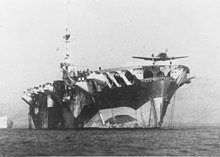HMSPretoria Castle(F61)
This articleneeds additional citations forverification.(October 2020) |
 HMSPretoria Castle
| |
| History | |
|---|---|
| Name | Pretoria Castle |
| Port of registry | |
| Builder | Harland & Wolff |
| Yard number | 1006[1] |
| Launched | 12 October 1938 |
| Completed | 18 April 1939[1] |
| Identification |
|
| Fate | Requisitioned forRoyal NavyOctober 1939 |
| Name | HMSPretoria Castle |
| Commissioned | 28 November 1939 |
| Decommissioned | August 1942 |
| Refit | Converted fromarmed merchant cruisertoescort carrier |
| Identification | Pennant numberF61 |
| Commissioned | 29 July 1943 |
| Decommissioned | 26 January 1946 |
| Fate | Sold back to theUnion-Castle Line1946 |
| Name | RMMVWarwick Castle |
| Port of registry | |
| Acquired | 1946 |
| Fate | Scrapped July 1962 |
| General characteristics | |
| Type | Ocean liner |
| Tonnage | 17,392GRT |
| Displacement | 23,450 tons |
| Length | 594 ft (181.1 m) |
| Beam | 76 ft (23.2 m) |
| Draught | 29 ft (8.8 m) |
| Installed power | 16,000bhp(12,000 kW); 3,284NHP |
| Propulsion | Diesel engines,twin screw |
| Speed | 18knots(33 km/h; 21 mph) |
| Aircraft carried | 21 |
HMSPretoria Castle(F61)was aUnion-Castleocean linerthat in theSecond World Warwas converted into aRoyal Navyarmed merchant cruiser,and then converted again into anescort carrier.After the war she was converted back into a passenger liner and renamedWarwick Castle.
History
[edit]
Harland and WolffbuiltPretoria CastleinBelfast,launching her in 1938 and completing her in April 1939.[2]TheAdmiraltyrequisitioned her for the Royal Navy in October 1939, and had her converted into an armed merchant cruiser with eight 6-inch (152 mm) and two 3-inch (76 mm) guns, entering service in November 1939. In this role she served mainly in theSouth Atlantic.
In July 1942 the Admiralty bought her outright for conversion to an escort carrier bySwan HunteronTyneside.For her new role her armament included tenOerlikon 20 mm cannon.[3]She was commissioned in her new role in July 1943. She operated as a trials and training carrier, seeing no active combat service.
In 1945 she twice became part of aviation history, firstly when Britishtest pilotCaptainEric "Winkle" Brownlanded aBellAiracobraMk. 1 on her flight deck - the first carrier landing made using an aircraft with a tricycle undercarriage, due to a declared emergency during initial trials forrubber decklandings planned for future carriers, and then by hosting the first ever landings and take-offs by a glider, performed by John Sproule in aSlingsby T.20as part of research into "round-down" turbulence. On 11 August 1946, while moored on the Clyde, aGloster Meteorwas used for deck handling trials which later led to flight trials on other carriers.[4]
After the war the ship was sold back to the Union-Castle Line in 1946 and converted back to a passenger liner, restored to its route betweenEnglandandSouth Africabut renamedWarwick Castle.She was sold and scrapped inBarcelonain July 1962.
Notes
[edit]- ^abMcCluskie, Tom (2013).The Rise and Fall of Harland and Wolff.Stroud: The History Press. p. 146.ISBN978-0752488615.
- ^Lloyd's Register of Shipping(PDF).London:Lloyd's Register.1939.Retrieved8 October2020.
- ^"HMS Pretoria Castle Gun 10 X BR 20mm 70cal Mark V VC Power Twin".NavHist.Flixco Pty Limited.Retrieved8 October2020.
- ^Mason, Geoffrey B."HMS Pretoria Castle (F 61) – Escort Aircraft Carrier".Service Histories of Royal Navy Warships in World War 2.Naval History.Retrieved27 February2016.
References
[edit]- Osborne, Richard; Spong, Harry & Grover, Tom (2007).Armed Merchant Cruisers 1878–1945.Windsor, UK: World Warship Society.ISBN978-0-9543310-8-5.
Further reading
[edit]- Brown, Eric.Wings of the Weird and Wonderful.[clarification needed]
- Brown, Eric(2007).Wings on My Sleeve.London: Weidenfeld & Nicolson.ISBN978-1407244518.[page needed]
External links
[edit]![]() Media related toHMS Pretoria Castle (F61)at Wikimedia Commons
Media related toHMS Pretoria Castle (F61)at Wikimedia Commons
- Drury, Tony."A history of HMS Pretoria Castle".Royal Navy Research Archive.
- Helgason, Guðmundur."HMS Pretoria Castle (F 61)".uboat.net.
- "UK/Union Castle".The Late, Great Ocean Liners.Archived fromthe originalon 17 March 2006.
